The Distillers Malt Market is estimated to be valued at USD 1.2 billion in 2025 and is projected to reach USD 1.8 billion by 2035, registering a compound annual growth rate (CAGR) of 4.0% over the forecast period.
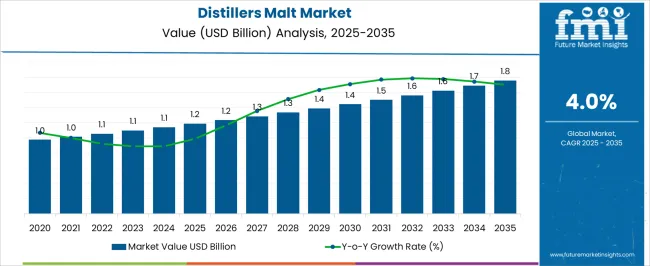
| Metric | Value |
|---|---|
| Distillers Malt Market Estimated Value in (2025 E) | USD 1.2 billion |
| Distillers Malt Market Forecast Value in (2035 F) | USD 1.8 billion |
| Forecast CAGR (2025 to 2035) | 4.0% |
The Distillers Malt market is experiencing steady growth driven by the increasing demand for high-quality malt in spirits production, particularly whiskey, vodka, and specialty liquors. The current market scenario is characterized by a rising preference for premium alcoholic beverages and a growing consumer focus on authenticity, flavor complexity, and heritage-based products.
Investment in distillery infrastructure, modernization of production processes, and adoption of innovative brewing and fermentation techniques are further supporting the market expansion. Rising disposable income and changing lifestyle preferences are encouraging the consumption of craft spirits and small-batch distillates, leading to higher demand for specialty malt.
Additionally, the emphasis on clean labeling, traceable raw materials, and quality assurance is influencing procurement decisions across regions The future outlook is shaped by increasing global trade of distilled beverages, growing interest in experimental flavor profiles, and the adoption of sustainable sourcing practices for barley and malt, which are expected to create long-term growth opportunities for the market.
The distillers malt market is segmented by form, barley type, malt type, end use, flavor, packaging, and geographic regions. By form, distillers malt market is divided into Crushed, Whole, Flour, and Extract. In terms of barley type, distillers malt market is classified into Two Row Barley and Six Row Barley. Based on malt type, distillers malt market is segmented into Diastatic Barley Malt, Diastatic Wheat Malt, Smoked Malt, Spelt Malt, Rye Malt, Munich Malt, and Others (Melanoidin Malt). By end use, distillers malt market is segmented into Whiskey, Food, Beverages, Scotch Whiskey, Irish Whiskey, Beer, Schnapps, Smokey Spirits, and American Style Bourbon. By flavor, distillers malt market is segmented into Caramel, Sweet, Honey, Fruity, Nutty, Coffee, Dark Chocolate, and Others (Raisins, Biscuit, Vanilla Etc.). By packaging, distillers malt market is segmented into Sack and Poly Bag. Regionally, the distillers malt industry is classified into North America, Latin America, Western Europe, Eastern Europe, Balkan & Baltic Countries, Russia & Belarus, Central Asia, East Asia, South Asia & Pacific, and the Middle East & Africa.
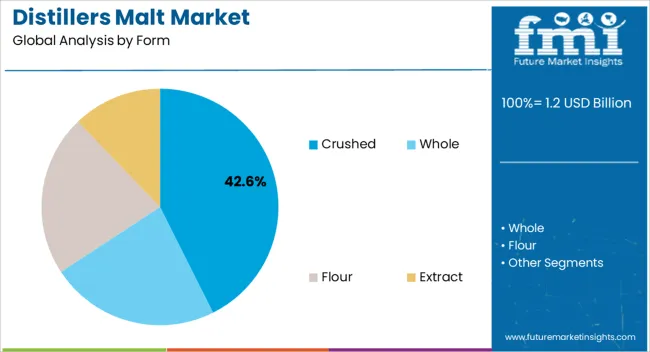
The crushed form segment is projected to hold 42.60% of the Distillers Malt market revenue share in 2025, positioning it as the leading form type. This dominance is being attributed to its ease of handling, consistent mash conversion, and compatibility with automated brewing and distillation systems.
Crushed malt allows for efficient enzymatic activity during mashing, improving sugar extraction rates and fermentation consistency, which is critical for producing high-quality spirits. The segment’s growth has been reinforced by increasing investments in commercial and craft distilleries, where efficiency and repeatability in production are paramount.
Furthermore, the ability to optimize mash recipes, control particle size, and maintain uniformity in large-scale operations has strengthened adoption The rising emphasis on cost-effective production, combined with the growing preference for standardized forms that can integrate seamlessly with modern processing equipment, is expected to sustain the leadership of the crushed malt form segment in the foreseeable future.
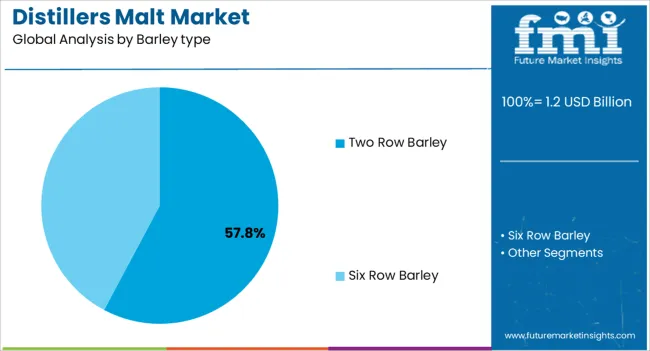
The two row barley segment is expected to account for 57.80% of the Distillers Malt market revenue share in 2025, making it the leading barley type. Its dominance is being driven by its superior enzyme content, uniform kernel size, and high extract potential, which support consistent fermentation and flavor development in spirits.
The segment has benefited from the growing demand for high-quality whiskey and craft distillates, where precise control over the brewing process is critical. Two row barley provides balanced protein levels, low husk content, and predictable starch profiles, which contribute to enhanced yield and reduced process variability.
Adoption has also been influenced by the crop’s widespread cultivation and reliable supply chain, ensuring year-round availability for distillers With distillers increasingly seeking raw materials that deliver repeatable quality and facilitate innovation in flavor profiles, two row barley is expected to remain the preferred choice, reinforcing its market leadership and long-term growth prospects.
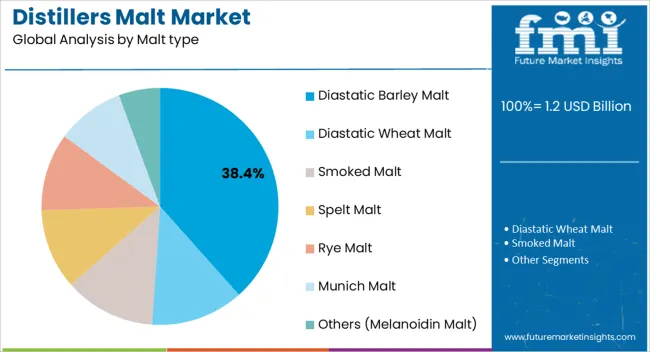
The diastatic barley malt segment is projected to hold 38.40% of the Distillers Malt market revenue share in 2025, emerging as the leading malt type. This dominance is being attributed to its high enzymatic activity, which promotes efficient starch conversion and sugar extraction during mashing. Diastatic malt is critical for ensuring robust fermentation, optimal alcohol yield, and consistency in spirit quality, particularly in whiskey and specialty liquors.
The segment has benefited from distillers’ increasing focus on process efficiency, product consistency, and flavor precision. Its versatility in blending with other malt types and the ability to enhance enzymatic performance in mash bills have reinforced adoption.
Additionally, diastatic malt supports scalability in both craft and industrial distilleries, enabling controlled experimentation with recipes and efficient production workflows With rising global demand for high-quality spirits and craft beverages, diastatic barley malt is expected to sustain its market leadership, driven by its key functional benefits and contribution to product excellence.
Distillers Malt is the whiskey malt kilned at low temperatures in order to preserve the enzymes in the grain. Distillers Malt has higher diastatic power as well as high alpha amylase concentration compared to the whiskey malt. Distillers Malt maximizes the alcohol production from grains with maintaining the flavor and color of the alcohol.
Distillers Malt requires high protein barley, resulting in the high levels of enzyme. These enzymes are preserved as much as possible during kilning step using lower heat and increased air flow. High levels of enzymes brings about higher conversion of sugar to alcohol during fermentation.
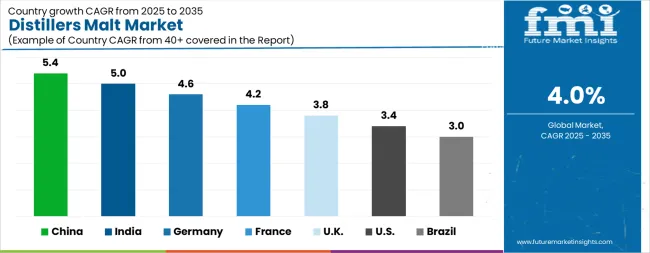
| Country | CAGR |
|---|---|
| China | 5.4% |
| India | 5.0% |
| Germany | 4.6% |
| France | 4.2% |
| UK | 3.8% |
| USA | 3.4% |
| Brazil | 3.0% |
The Distillers Malt Market is expected to register a CAGR of 4.0% during the forecast period, exhibiting varied country level momentum. China leads with the highest CAGR of 5.4%, followed by India at 5.0%. Developed markets such as Germany, France, and the UK continue to expand steadily, while the USA is likely to grow at consistent rates. Brazil posts the lowest CAGR at 3.0%, yet still underscores a broadly positive trajectory for the global Distillers Malt Market. In 2024, Germany held a dominant revenue in the Western Europe market and is expected to grow with a CAGR of 4.6%. The USA Distillers Malt Market is estimated to be valued at USD 410.8 million in 2025 and is anticipated to reach a valuation of USD 573.9 million by 2035. Sales are projected to rise at a CAGR of 3.4% over the forecast period between 2025 and 2035. While Japan and South Korea markets are estimated to be valued at USD 64.3 million and USD 36.7 million respectively in 2025.
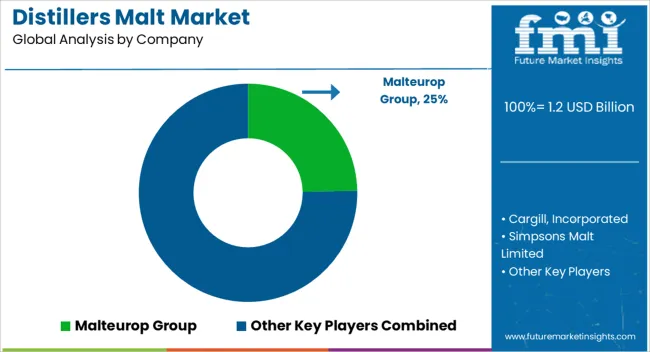
| Item | Value |
|---|---|
| Quantitative Units | USD 1.2 Billion |
| Form | Crushed, Whole, Flour, and Extract |
| Barley type | Two Row Barley and Six Row Barley |
| Malt type | Diastatic Barley Malt, Diastatic Wheat Malt, Smoked Malt, Spelt Malt, Rye Malt, Munich Malt, and Others (Melanoidin Malt) |
| End use | Whiskey, Food, Beverages, Scotch Whiskey, Irish Whiskey, Beer, Schnapps, Smokey Spirits, and American Style Bourbon |
| Flavor | Caramel, Sweet, Honey, Fruity, Nutty, Coffee, Dark Chocolate, and Others (Raisins, Biscuit, Vanilla Etc.) |
| Packaging | Sack and Poly Bag |
| Regions Covered | North America, Europe, Asia-Pacific, Latin America, Middle East & Africa |
| Country Covered | United States, Canada, Germany, France, United Kingdom, China, Japan, India, Brazil, South Africa |
| Key Companies Profiled | Malteurop Group, Cargill, Incorporated, Simpsons Malt Limited, Crisp Malting Group, and GrainCorp Malt |
The global distillers malt market is estimated to be valued at USD 1.2 billion in 2025.
The market size for the distillers malt market is projected to reach USD 1.8 billion by 2035.
The distillers malt market is expected to grow at a 4.0% CAGR between 2025 and 2035.
The key product types in distillers malt market are crushed, whole, flour and extract.
In terms of barley type, two row barley segment to command 57.8% share in the distillers malt market in 2025.






Our Research Products

The "Full Research Suite" delivers actionable market intel, deep dives on markets or technologies, so clients act faster, cut risk, and unlock growth.

The Leaderboard benchmarks and ranks top vendors, classifying them as Established Leaders, Leading Challengers, or Disruptors & Challengers.

Locates where complements amplify value and substitutes erode it, forecasting net impact by horizon

We deliver granular, decision-grade intel: market sizing, 5-year forecasts, pricing, adoption, usage, revenue, and operational KPIs—plus competitor tracking, regulation, and value chains—across 60 countries broadly.

Spot the shifts before they hit your P&L. We track inflection points, adoption curves, pricing moves, and ecosystem plays to show where demand is heading, why it is changing, and what to do next across high-growth markets and disruptive tech

Real-time reads of user behavior. We track shifting priorities, perceptions of today’s and next-gen services, and provider experience, then pace how fast tech moves from trial to adoption, blending buyer, consumer, and channel inputs with social signals (#WhySwitch, #UX).

Partner with our analyst team to build a custom report designed around your business priorities. From analysing market trends to assessing competitors or crafting bespoke datasets, we tailor insights to your needs.
Supplier Intelligence
Discovery & Profiling
Capacity & Footprint
Performance & Risk
Compliance & Governance
Commercial Readiness
Who Supplies Whom
Scorecards & Shortlists
Playbooks & Docs
Category Intelligence
Definition & Scope
Demand & Use Cases
Cost Drivers
Market Structure
Supply Chain Map
Trade & Policy
Operating Norms
Deliverables
Buyer Intelligence
Account Basics
Spend & Scope
Procurement Model
Vendor Requirements
Terms & Policies
Entry Strategy
Pain Points & Triggers
Outputs
Pricing Analysis
Benchmarks
Trends
Should-Cost
Indexation
Landed Cost
Commercial Terms
Deliverables
Brand Analysis
Positioning & Value Prop
Share & Presence
Customer Evidence
Go-to-Market
Digital & Reputation
Compliance & Trust
KPIs & Gaps
Outputs
Full Research Suite comprises of:
Market outlook & trends analysis
Interviews & case studies
Strategic recommendations
Vendor profiles & capabilities analysis
5-year forecasts
8 regions and 60+ country-level data splits
Market segment data splits
12 months of continuous data updates
DELIVERED AS:
PDF EXCEL ONLINE
Malt Sprouts Market Size and Share Forecast Outlook 2025 to 2035
Malted Rye Flour Market Size and Share Forecast Outlook 2025 to 2035
Malted barley flour Market Size and Share Forecast Outlook 2025 to 2035
Malt Beverage Market Analysis - Size, Share, and Forecast Outlook 2025 to 2035
Malted Milk Market Size and Share Forecast Outlook 2025 to 2035
Malt Ingredients Market Analysis by Raw Material, Product Type, Grade, End-use, and Region through 2035
Malt Market Trends and Forecast 2025 to 2035
Analysis and Growth Projections for Maltodextrin Business
Maltitol Market Analysis by form, end use industry and by region – Growth, trends and forecast from 2025 to 2035
Malted Milk Powder Market Trends - Growth & Industry Forecast 2025 to 2035
Malted Wheat Flour Market
Isomalt Market Analysis - Size, Share, and Forecast 2025 to 2035
Isomalt Industry in Japan – Growth & Industry Trends 2025 to 2035
Isomalt Industry Analysis in Western Europe – Size, Share & Forecast 2025 to 2035
Isomaltulose Market Growth - Size, Trends & Forecast 2025 to 2035
Isomalto-oligosaccharide Market Analysis by Form, Source, End-use Application and Region through 2035
Dry Malt Products Market
Wheat Malt Market Size and Share Forecast Outlook 2025 to 2035
Dried Distillers' Grains with Soluble Market
Kilned Malt Market Size and Share Forecast Outlook 2025 to 2035

Thank you!
You will receive an email from our Business Development Manager. Please be sure to check your SPAM/JUNK folder too.
Chat With
MaRIA